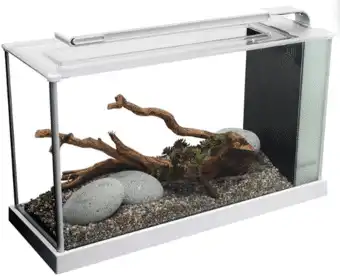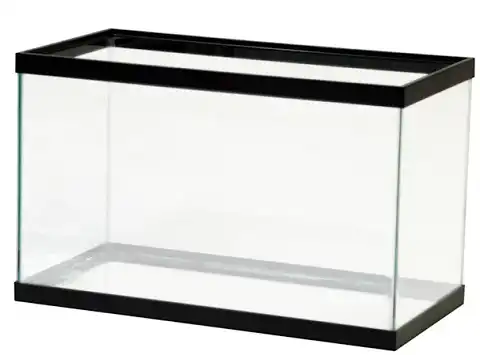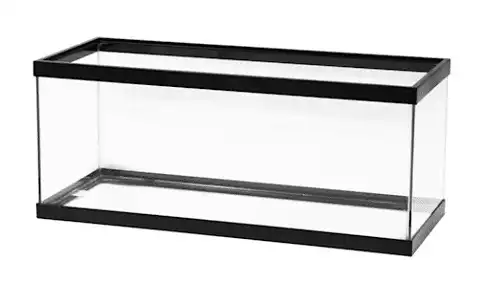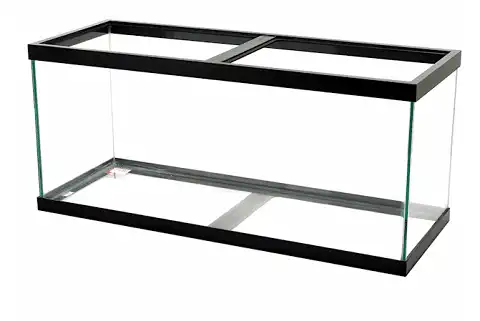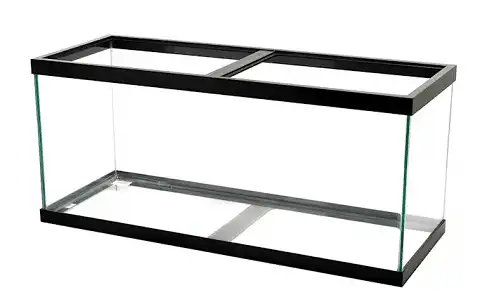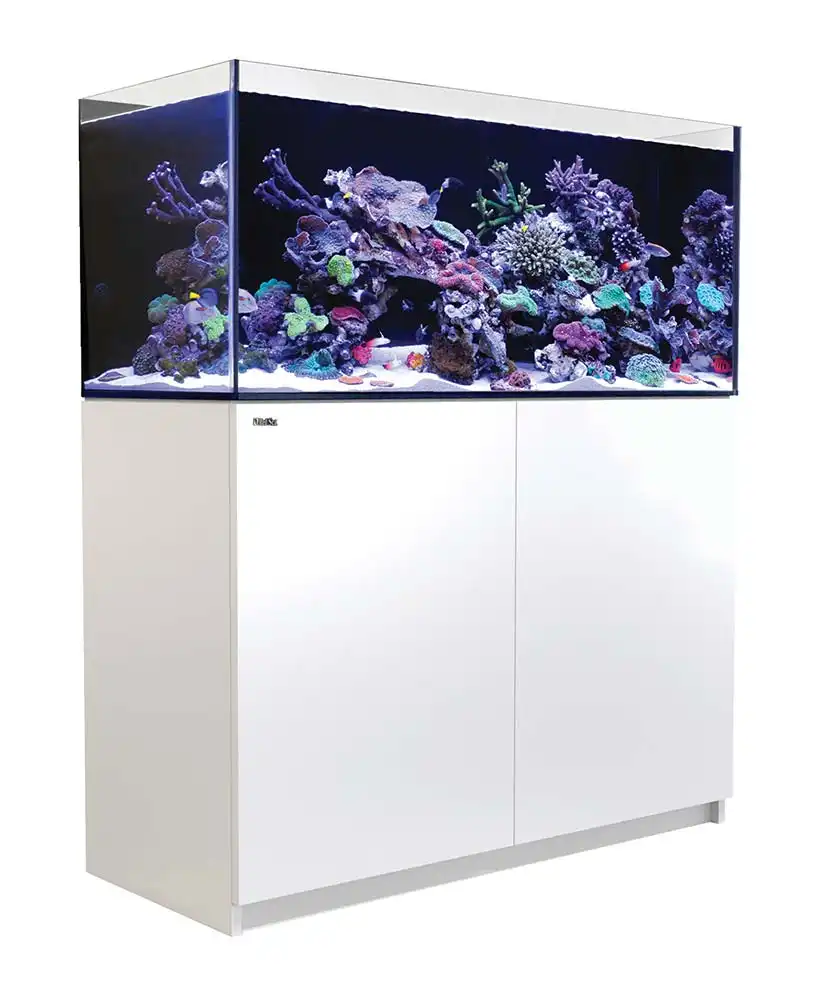Thank you for visiting! By the way… any links on this page that lead to products on Amazon and other stores/partners are affiliate links Aquarium Store Depot earns a commission if you make a purchase.
Are you looking to get a new aquarium? Choosing the right size for your space, and the fish you want to keep is extremely important, and that’s why I’m writing this practical guide. We’ll take a look at the standard tank sizes, their measurements, and the pros and cons of each of the aquarium sizes we overview.
So let’s get started!
Key Takeaways
- Bigger is always better for your fish.
- Weight is important when choosing fish tank sizes. Each gallon of water already weighs 8.3 pounds, but empty weight, substrate, and hardscape all add up.
- Consider your available space, budget, and the kind of fish you want to keep before choosing your tank size.
- Large tanks require less frequent maintenance than small fish tanks.
Choosing A Tank – What To Consider
Setting up a fish tank is a long-term commitment, so it’s not something you want to jump into without considering all the facts. Let’s take a look at the most important factors when choosing aquarium dimensions.
Size
The length, depth, and height of your aquarium determine which kind of fish you can keep. Different species grow to different sizes and have different activity levels and territorial behaviors.
If you are setting up an aquarium for a specific species, you’ll need to research its minimum tank size first.
Weight
Water is surprisingly heavy, and so is glass and aquarium substrate. The weight of your aquarium is usually more important to think about than its size. Aquariums in the 5 to 15-gallon size range can often be kept on sturdy furniture, but anything bigger is going to require a proper stand.
Consider both the empty and full weight of a tank, and remember, it’s not only the stand that you need to consider but also what’s underneath it.
There are definite limits to the amount of weight your floor can handle, and that depends on a bunch of factors, like which floor you’re on and how your building was built.
Power
Aquariums need electricity to run, and the larger your tank, the larger your power bill. Most aquariums require heating, and all need filtration. Modern aquarium hardware is very energy efficient, but keeping a large tank warm in a cold environment is going to need energy. Some older homes, especially with reef tanks, make not have the breakers to handle a larger setup.
20 amps circuits are ideal for larger high-powered setups.
Cost
Generally speaking, aquarium prices increase with size. The same rule applies to hardware, lighting, decor, substrate, stands, and pretty much everything else.
Permission
You’ll need to consult your landlord/lady about permission to keep an aquarium if you’re renting, and size might well be an issue. There might also be weight limits in your building, so do your homework before you buy something too big.
Maintenance
Aquarium maintenance is one factor that actually decreases with aquarium size. Basically, the larger a tank, the more stable its water quality and the less maintenance it needs per gallon. Of course, this one’s really going to depend on how many fish you keep, how big they are, and what they eat.
Standard Aquarium Sizes
Aquariums come in all shapes and sizes, including cylinders, bow front, and hexagons (see our video above from our YouTube Channel). Their designs vary slightly depending on the manufacturer, and even the material they are made of varies, with glass aquariums and acrylic aquariums being the most popular options.
Choosing odd aquarium shapes and sizes takes careful planning, but fortunately, most fish tanks come in standard rectangular sizes. Standard-size glass tanks are also easy to find in kits that may include a hood, lighting, and sometimes other equipment like stands, heaters, and filters.
Even though standard fish tank sizes are, well, standard, there may be a slight difference in actual aquarium dimensions between different manufacturers and by trim type. I recommend you confirm the exact dimensions with a tape measure before you buy the wrong box!
Keep reading as we look at standard fish tank size options and the pros and cons of each one.
Small Fish Tanks
Small aquariums vary from less than a gallon up to 15 gallons. The major benefits of a small aquarium tank are low cost, and low space requirements, although they are not necessarily easier to maintain. Small tanks are recommended for small freshwater fish and invertebrates.
Let’s take a look at some popular small aquarium tank size options.
5-Gallon Tank
The 5-gallon aquarium is the smallest size you should consider for keeping fish. This is a great tank size for your desk at home, at work, or even at your bedside.
However, your options are very limited when it comes to choosing fish, and maintaining good water quality can be tricky. This aquarium size is best if you want a single betta or inverts in a compact freshwater tank.
The Best 5 Gallon Fish Tank
The best filtration, best light, and perfect size. Everything you need to get started. It's the perfect small tank!
Dimensions: (L x W x H): 16 x 8 x 10 inches or 41 x 20 x 25 centimeters
Dry Weight: 7 pounds or 3.2 kilograms
Wet Weight: 62 pounds or 28 kilograms
Pros
- Lightweight
- Low cost
Cons
- Limited choices of fish
- High maintenance needs
Stocking options
- Betta
- Pea Puffer
- Endlers livebearer trio
- Some nano schooling species like chili rasboras
10-Gallon Tank
A ten-gallon fish tank is still considered a nano aquarium, although it provides more options when choosing aquatic pets. Ten-gallon tanks are cheap to set up, and a little easier to maintain than the 5-gallon size. These tanks are also easy to find as complete kits.
Your standard 10 gallon tank. Goes on sale at local Petcos for cheap
Dimensions: (L x W x H): 20 x 10 x 12 inches or 51 x 25 x 30 centimeters
Dry Weight: 11 pounds or 5 kilograms
Wet Weight: 111 pounds or 50 kilograms
Pros
- Affordable aquarium and hardware
- Does not require an aquarium stand
Cons
- Still too small for a community tank
- Needs careful maintenance
Stocking Options
- Small tetras like the ember tetra
- Dwarf gouramis
- Dwarf/pygmy corydoras
- White cloud minnows
Medium Fish Tanks
Medium fish tanks are the ideal choice for beginners who want a wide choice of fish species. The water volume in these tanks allows a little more room for error than in a small tank, although their filled weight makes them too heavy for most home furniture.
Read on to learn about the most popular medium-sized fish tanks.
20-Gallon Tanks
The 20-gallon aquarium size opens up a whole lot more options for fish keepers because these fish tanks are great for small, peaceful communities. This is also the minimum recommended size for saltwater fish like clownfish.
A classic 20 gallon aquarium in its 30 inch long variant. A very popular aquarium.
The 20-gallon capacity aquarium is available in two standard sizes with the same capacity. The long option is generally preferred, although the 20-gallon high is also a great choice, particularly if you want to grow taller plants or don’t have a lot of floor space for your aquarium.
Dimensions: (L x W x H):
- Long 30 x 12 x 12 inches or 76 x 30 x 30 centimeters
- High 24 x 12 x 16 inches or 61 x 30 x 41 centimeters
Dry Weight: 25 pounds or 11 kilograms
Wet Weight: 225 pounds or 102 kilograms
Pros
- Great tank size for a small community
- Easier to maintain than smaller tanks but still light and compact
Cons
- May require a stand
- Still too small for many popular tropical fish species
Stocking options
- Most small community schooling fish like barbs, danios, tetras, etc.
- Dwarf Cichlids
- Livebearers
29-Gallon Tank
The 29-gallon aquarium is one of the best all-round choices, particularly for beginner fish keepers. This is the minimum tank size for many medium-sized freshwater fish like goldfish and angelfish, although it is also an excellent size for a busy community of small fish.
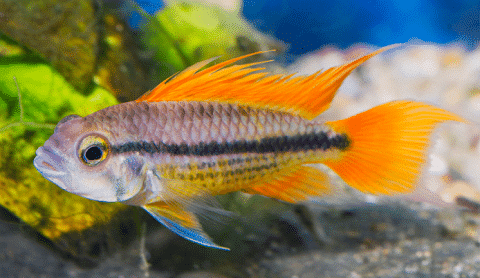
The 29-gallon fish tank is also a step up in height, which is great for growing a variety of aquarium plants. This aquarium size is also great as a hospital or quarantine tank for medium and larger fish.
Dimensions: (L x W x H): 30 x 12 x 18 inches or 76 x 30 x 46 centimeters
Dry Weight: 40 pounds or 18 kilograms
Wet Weight: 330 pounds or 150 kilograms
Pros
- Stable water parameters
- Enough room for a variety of different fish
- Available in kit form
Cons
- At over 300 pounds, this fish tank usually requires a well-built aquarium stand
Stocking options
- A varied community, including centerpiece fish, bottom dwellers, and schooling fish
- Angelfish
- Fancy goldfish
40-Gallon Tanks
The 40-gallon aquarium allows you to keep ‘wet pets’ like the blood parrot cichlid or even younger specimens of larger species like oscars and flowerhorns.
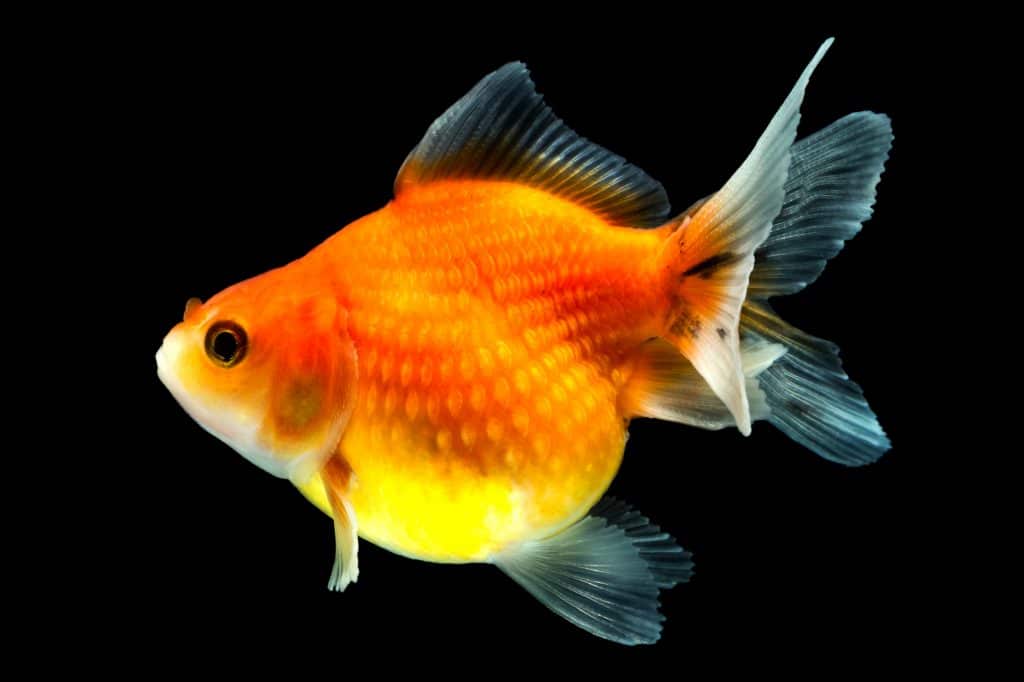
This is a great tank size for three or four fancy goldfish with good filtration or even a cool water setup with a slow-swimming fancy goldfish and some white cloud minnows or ricefish.
40-gallon tanks are available in a ‘breeder’ tank or a standard long shape, which is longer and narrower but has the same depth. The longer option is a great size for more active swimming fish like giant danios.
Dimensions (L x W x H):
- Breeder 36 x 18 x 16 inches or 91 x 46 x 41 centimeters
- Long 48 x 12 x 16 inches or 122 x 30 x 41 centimeters
Dry Weight: 58 pounds or 26 kilograms
Wet Weight: 458 pounds or 207 kilograms
Pros
- Big enough for larger, single fish
- Great size for a planted community tank
- Available in two shapes
Cons
- Requires a dedicated stand
Stocking options
Large Fish Tanks
Large aquariums are necessary to provide a healthy home for medium to large salt and freshwater fish. Aquarium weight becomes more important than aquarium dimensions when setting up these tanks, especially if you live above the ground floor.
Let’s take a look at some popular options and what you can keep in them.
55-Gallon Tank
The 55-gallon aquarium size is entering the category of large aquariums. This is the minimum tank size for an African cichlid community, although your options are limited to a few species.
The 55-gallon aquarium is a great budget-friendly larger tank. It often goes on sale at chain pet stores.
You can also keep some of the larger Central American cichlids in this aquarium tank size, including oscars and severums. Of course, all the fish mentioned for smaller tanks will also be happy in this larger tank size.
Dimensions: (L x W x H): 48 x 13 x 21 inches or 122 x 33 x 53 centimeters
Dry Weight: 78 pounds or 35 kilograms
Wet Weight: 628 pounds or 285 kilograms
Pros
- Stable water conditions
- Variety of stocking options, including saltwater fish
Cons
- Increased depth makes reaching the substrate more difficult during maintenance
- Too large for sponge filtration
Stocking options
- Varied community tank with angelfish school
- Small African cichlid community
75-Gallon Tank
The 75-gallon aquarium is 4 feet long, just like the 55-gallon, but the extra width just increases the amount of floor space in the tank, allowing you to create a more diverse aquascape and keep even more fish or larger species.
Your standard 75 gallon aquarium. 4 foot dimensions and fits most stands available at fish stores
This is a great size to create a healthy long-term home for large Central American cichlids like Jack Dempseys and Flowerhorns.
Dimensions: (L x W x H): 48 x 18 x 21 inches or 122 x 46 x 53 centimeters
Dry Weight: 140 pounds or 64 kilograms
Wet Weight: 850 pounds or 386 kilograms
Pros
- Ideal long-term home for wet pets like full-grown Oscar cichlids
Cons
- Does not offer many benefits over the 55-gallon but is significantly heavier
Stocking options
- Large cichlids like oscars or flowerhorns
- a small group of discus
- Medium-sized community fish like silver dollars and rainbowfish
- Saltwater reef tank
125-gallon Tank
The 125-gallon tank is an excellent 6-foot option for serious fish keepers. Setting up a large aquarium takes time, but the results can be amazing!
The newest generation Red Sea Reefers offer a great all in one system for anyone looking for a saltwater aquarium
There’s almost no limit to the variety of fish you can keep in a tank of this size, and they are pretty easy to find. In fact, 6-foot tanks are often available in kit form.
Dimensions: (L x W x H): 72 x 18 x 21 inches or 183 x 46 x 53 centimeters
Dry Weight: 206 pounds or 93 kilograms
Wet Weight: 1400 pounds or 635 kilograms
Pros
- Big enough for most popular salt and freshwater aquarium fish in the hobby
- Makes a real statement in any room
Cons
- A large investment of time and money
Stocking options
- Larger groups of severums, discus, or angelfish
- Aggressive fish tanks
- Large saltwater reef tank
150-gallon Tank
The 150-gallon has all the same benefits as the 125 but has that little bit of extra volume for added water stability. It has the same dimensions at the bottom, which means you don’t need to spend more on substrate and hardscape, which really adds up to the cost of a tank setup.
Dimensions: (L x W x H): 72 x 18 x 28 inches or 183 x 46 x 71 centimeters
Dry Weight: 338 pounds or 153 kilograms
Wet Weight: 1800 pounds or 816 kilograms
Pros
- This aquarium tank has the same floor space as the 125 but even more water volume
- The extra height of a 150 allows more complex aquascaping options
Cons
- Complete 150-gallon tanks are extremely heavy and often unsuitable for upper floors
- Extra depth makes maintenance more difficult
Stocking options
- Almost all the well-known freshwater aquarium fish and most large variety of reef species
- Huge schools of tetras and other small fish
- Large cichlids
- Various catfish
Larger Tanks
When it comes to fishkeeping, bigger is almost always better. Fish live out in rivers, lakes, and oceans where they have huge amounts of space to swim and explore. This means that aquariums are never too big for fish, but they are often too small.
If you have the space, budget, and floor strength for a larger aquarium, why not go all out and build your dream setup? Your fish will thank you for it!
Quick Tank Chart
For those who prefer a quick list to reference, here is a chart with all the aquarium sizes we discussed. Happy shopping!
| Gallons | Dimensions (Imperial) – LxWxH | Dimensions (Metric) – LxWxH | Estimated Filled Weight |
| 5 Gallon | 16 x 8 x 10 inches | 41 x 20 x 25 centimeters | 62 lbs (28 KG) |
| 10 Gallon | 20 x 10 x 12 inches | 51 x 25 x 30 centimeters | 111 lbs (50 KG) |
| 20 Gallon Long | 30 x 12 x 12 inches | 76 x 30 x 30 centimeters | 225 lbs (102 KG) |
| 20 Gallon High | 24 x 12 x 16 inches | 61 x 30 x 41 centimeters | 225 lbs (102KG) |
| 29 Gallon | 30 x 12 x 18 inches | 76 x 30 x 46 centimeters | 330 lbs (150 KG) |
| 40 Gallon Breeder | 36 x 18 x 16 inches | 91 x 46 x 41 centimeters | 458 lbs (207 KG) |
| 40 Gallon Long | 48 x 12 x 16 inches | 122 x 30 x 41 centimeters | 458 lbs (207 KG) |
| 55 Gallon | 48 x 13 x 21 inches | 122 x 33 x 53 centimeters | 628 lbs (295 KG) |
| 75 Gallon | 48 x 18 x 21 inches | 122 x 46 x 53 centimeters | 850 lbs (385 KG) |
| 125 Gallon | 72 x 18 x 21 inches | 183 x 46 x 53 centimeters | 1400 lbs (635 KG) |
| 150 Gallon | 72 x 18 x 28 inches | 183 x 46 x 71 centimeters | 1800 lbs (816 KG) |
FAQs
What is a good fish tank choice?
All fish tank sizes have their place, it really depends on the kind of fish you wish to keep. Standard-size aquariums tend to be the most affordable and easiest to find. If you’re just starting out and want a small and affordable tank that can hold plenty of beautiful community fish, consider a 29-gallon capacity tank.
Larger pet fish like oscars usually need 55 gallons or more, but you can scale down to a betta tank of just 5 gallons if you want a wonderful small pet fish.
How big is a 24x12x12 tank?
A 24 x 12 x 12-inch tank is a standard 15-gallon or 2-foot aquarium. This is an excellent size for a nano community aquarium or a basic planted tank with small schooling tetras. There are many stocking options available for this tank size, although the small volume of water makes frequent maintenance important.
What are the dimensions of a standard tank?
Standard tank dimensions vary depending on the volume of water they hold. Popular small aquarium sizes include 2-foot, 3-foot, and 4-foot tanks.
Is Taller Or Wider Better?
Wider tanks are better than taller tanks in most situations. A bigger surface area or ‘footprint’ provides more space for swimming, territories, and aquascaping. However, there are some cases where a tall tank is ideal. Tall fish species like angelfish require deeper water and many of the taller stem plants will not fit in shallow planted aquariums.
Final Thoughts
Choosing your aquarium’s dimensions takes careful planning, but that doesn’t mean it can’t be fun! Use this guide to help make an informed decision; just remember to factor in how much space you have and the water weight on your tank before making a purchase.
What is your favorite tank size? Let us know in the comments below! Also check out our YouTube channel for more videos.
- About the Author
- Latest Posts
I’m thrilled that you found Aquarium Store Depot! Here you’ll find information on fish, aquariums, and all things aquatics related. I’m a hobbyist (being doing this since I was 11) and here to help other hobbyists thrive with their aquariums! I adhere to a high quality Editorial Process and Review products with real life field usage and practical analysis.


